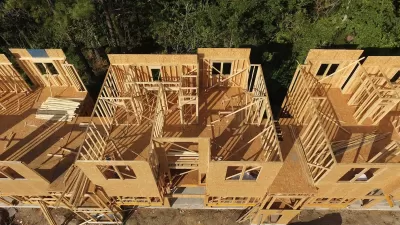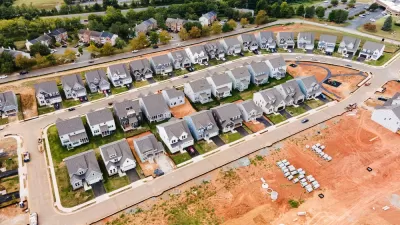Nationwide increases in housing stock since 2020 mirror post-pandemic moving patterns, with six states in the West and South accounting for half of new units.

“The United States has added almost 5 million housing units since 2020, most heavily in the South and most of them single-family homes, making a housing shortage look conquerable in much of the nation,” reports Tim Henderson for Stateline. According to Stateline analysis of Census Bureau data, six states account for 50 percent of the increase: Texas, Florida, California, North Carolina, Georgia, and Tennessee. Last year alone produced the most housing units since 2007.
Henderson notes that the pattern mirrors post-pandemic moving patterns but points out that experts say another 2 to 2.5 million units, mostly single-family homes, are needed. The US has added 1.6 million new units annually for the past two years, according to the Census Bureau data, and that pace is expected to continue.
However, while increased stock may mean cost increases could slow or stabilize, it doesn’t necessarily mean housing prices will come down, as high interest rates continue to hurt potential homebuyers and inflation drives up the cost of building materials and labor. “The Federal National Mortgage Association, known as Fannie Mae, reported last year that the typical homebuyer paid 35% of their income in mortgage payments in October, the highest since at least 2000,” writes Henderson.
States with affected by poverty and low population growth — including Rhode Island, Illinois, West Virginia, Connecticut, Alaska and New Jersey — saw the slowest housing growth, according to Stateline analysis of Census Bureau data.
FULL STORY: Housing boom in most of the US could ease shortage, but cost is still a problem

Alabama: Trump Terminates Settlements for Black Communities Harmed By Raw Sewage
Trump deemed the landmark civil rights agreement “illegal DEI and environmental justice policy.”

Study: Maui’s Plan to Convert Vacation Rentals to Long-Term Housing Could Cause Nearly $1 Billion Economic Loss
The plan would reduce visitor accommodation by 25% resulting in 1,900 jobs lost.

Why Should We Subsidize Public Transportation?
Many public transit agencies face financial stress due to rising costs, declining fare revenue, and declining subsidies. Transit advocates must provide a strong business case for increasing public transit funding.

Wind Energy on the Rise Despite Federal Policy Reversal
The Trump administration is revoking federal support for renewable energy, but demand for new projects continues unabated.

Passengers Flock to Caltrain After Electrification
The new electric trains are running faster and more reliably, leading to strong ridership growth on the Bay Area rail system.

Texas Churches Rally Behind ‘Yes in God’s Back Yard’ Legislation
Religious leaders want the state to reduce zoning regulations to streamline leasing church-owned land to housing developers.
Urban Design for Planners 1: Software Tools
This six-course series explores essential urban design concepts using open source software and equips planners with the tools they need to participate fully in the urban design process.
Planning for Universal Design
Learn the tools for implementing Universal Design in planning regulations.
Caltrans
Smith Gee Studio
Institute for Housing and Urban Development Studies (IHS)
City of Grandview
Harvard GSD Executive Education
Toledo-Lucas County Plan Commissions
Salt Lake City
NYU Wagner Graduate School of Public Service





























